CONDITIONING FOR BOXING: THE BOXING SCIENCE METHOD
Considering the gruelling nature of boxing and the significant physiological stress imposed on the athletes during sparring and competition, robust conditioning strategies are required to adequately prepare the athlete for the demands of the sport.
Furthermore, due to the short duration of camps with fighters taking opportunities on short notice, the conditioning methods employed must induce the desired adaptations rapidly. Simply, we need to get our athletes as fit as possible as soon as possible.
Many coaches and training teams employ various conditioning methods. At Boxing Science, our conditioning philosophy is grounded in scientific research and is applied effectively with the aid of practical experience developed throughout the years.
In this article you will learn about:
The underlying physiological mechanisms that contribute to boxing performance.
The science behind our interval training methods.
Practical recommendations on how to apply the conditioning principles that we use at Boxing Science with our boxers.
PHYSIOLOGICAL DEMANDS OF BOXING
Substantial research has examined the physiological responses to boxing competition and simulated competition and ultimately forms the foundation of our conditioning strategy.
From an investigation into the physiological demands of three by two minute rounds, we can conclude that aerobic metabolism contributes the most to overall energy production (77%).
Both anaerobic (absence of oxygen) energy systems also contribute to the energy produced during competition. Phosphocreatine, considered an immediate energy source with the fastest rate of ATP turnover, is responsible for 19% of energy used whilst 4% of energy expenditure is derived from anaerobic glycolysis.

From this research, it is evident that aerobic capacity is vital to boxing performance in terms of producing sufficient energy during competition.
Aerobic metabolism is also considered to set the upper limit of performance and determine the athlete’s ability to consistently repeat high-intensity efforts that lead to a stoppage.
Recovery during rounds is also regulated by aerobic metabolism and therefore comprehensive development of this system enables the athlete to enter each round with more energy at their disposal.
This can have a significant impact on a boxer’s ability to maintain technique and composure along with delaying the onset of fatigue during each round.
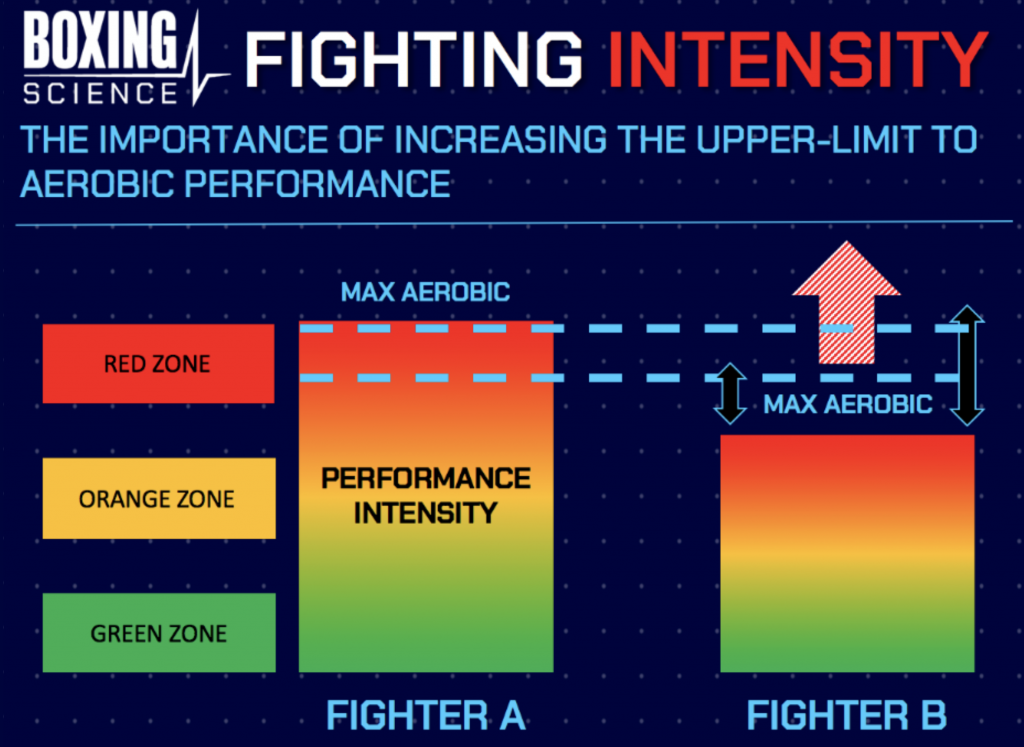
AEROBIC METABOLISM…WHAT IS IT?
In basic terms aerobic metabolism refers to a series of reactions, that rely on the presence of oxygen to produce energy.
Energy is generated aerobically through oxidative phosphorylation, which refers to the addition of a phosphate molecule to the basic unit of energy, Adenosine Triphosphate or ATP.
How do we measure aerobic capacity?
The most popular means of assessing an athlete’s aerobic capacity, is through V02 max testing.
V02 max is the term used to describe the maximal amount of oxygen that can be inspired, transported through the blood and used to produce energy during exercise.
Considering this definition, we can highlight the two key aspects that dictate aerobic capacity: Delivery of oxygen to the muscle cell and the utilisation of transported oxygen by the working muscles.
Through appropriate training strategies we can induce positive adaptations in the central structures that are responsible for the delivery of oxygen and also significantly alter the inner mechanics of the muscle cell, improving the efficiency of oxygen extraction and utilisation.
OUR CONDITIONING PHILOSOPHY
Our sport science and exercise physiology background is at the centre of our conditioning philosophy.
We firmly believe in training the adaptation, not necessarily the exercise.
In other words, we identify the needs of a given athlete and the goals of a particular training phase and proceed to implement the conditioning strategies that have been proven to elicit the adaptations we are looking for, whether that be central or peripheral.
The main training strategies we use at Boxing Science include:
Sprint Interval Training (SIT)
High Intensity Interval Training (HIIT)
Muscle Buffering
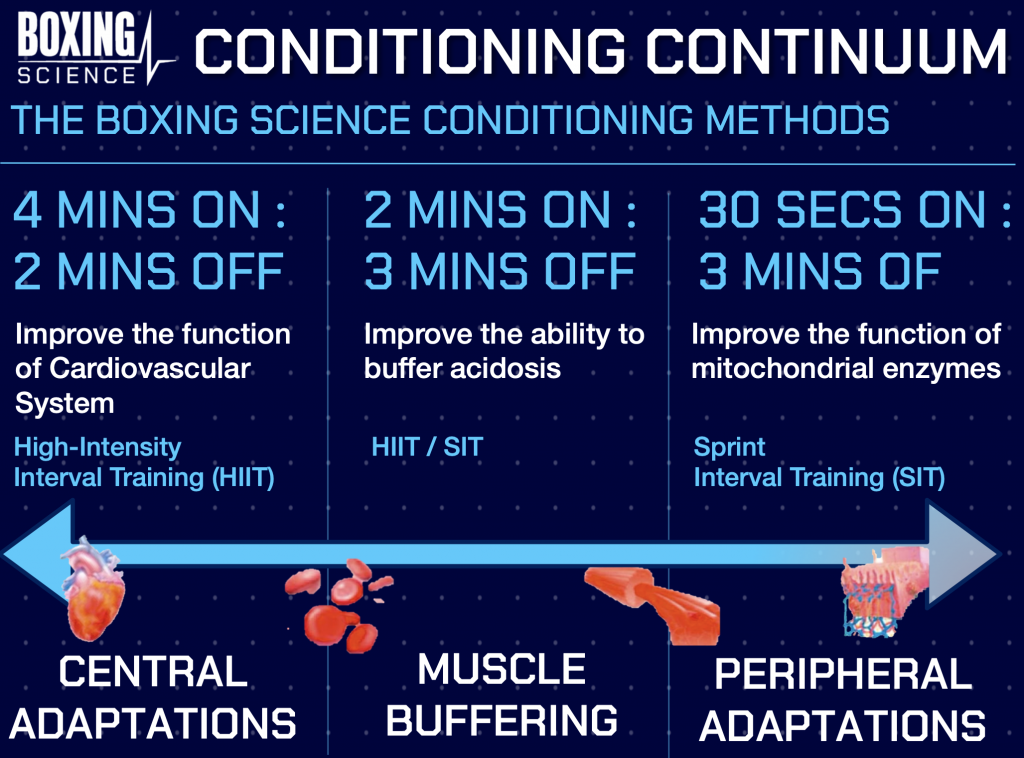
SPRINT INTERVAL TRAINING
These sessions consist of all-out maximal efforts, up to 30 seconds, and are separated by lengthy rest periods, to maintain intensity across the entirety of the session.
Our most renowned sprint interval sessions includes 30 seconds maximal sprints, separated by 3-4 minutes of rest and repeated 4-6 times.
That’s correct, TWO MINUTES of running is all our athletes may do in their first sprint interval session with us.
Though this may be appear to be too brief to elicit any worthwhile adaptations for an extremely demanding sport such as boxing, the intensity of these sprints, makes them a potent conditioning stimulus.
SCIENCE BEHIND 30 SECONDS MAX SPRINTS
The idea behind 30 second maximal sprints is to target peripheral adaptations and enhance the muscle’s ability to extract and utilise oxygen from the blood.
Intent during each repetition is key, as we want to deplete immediate sources of energy rapidly.
The depletion of these substrates (Phosphocreatine and Glycogen) along with the onset of acidosis, initiates a series of reactions and cell-signalling responses that facilitates mitochondrial gene expression.
The mitochondria are widely regarded as the engines of bodily cells and in muscle cells these structures are responsible for the utilisation of oxygen to produce energy.
Thus, increasing mitochondrial biogenesis has a significant impact on aerobic capacity and therefore enables our athletes to work at higher intensities for longer and also to recover better in between rounds.
Despite what many people may perceive as an anaerobic dominant session, due to the intensity and duration of each repetition, the disturbance of homeostasis within the muscle cell, leads to signalling responses that facilitate aerobic pathway development.
ADDITIONAL BENEFITS OF SIT
Performing maximal efforts for 30 seconds recruits a large amount of muscle, similar to that experienced during heavy squatting. This can improve overall fore production and rate of force development due to the recruitment of fast-twitch motor units.
Sprint-interval training allows the body to become familiar with using carbohydrate as a fuel source. This is important for boxing, as these athletes need to be efficient in using this substrate for high force actions in the ring.
Applying maximal effort for an extended duration creates an extreme acidic environment due to the rapid accumulation of lactate and hydrogen ions in the blood. Exposure to acidosis is important in a physiological sense, but also pushes an athlete’s grit and determination to the limit.
HOW AND WHERE TO PERFORM 30s MAX SPRINTS
As mentioned previously, intent is pivotal to make the most of each sessions.
Avoid pacing strategies for the thirty second bout, really ATTACK each repetition from the off.
In terms of location, in an ideal scenario, a curved treadmill is the optimal piece of equipment to perform these sessions on.
Though curves are growing in popularity, many people will not have access to them, here’s some alternative ways to perform sprint intervals:

When performing any conditioning session, it is important to quantify training performance.
Using the curve, we record speeds at 7, 17 and 27 seconds of each rep to get an insight into our athletes peak speed and their rate of drop off.
When on the Watt bike, power outputs can be recorded quite easily. Again recording power at 7, 17 and 27 seconds will provide an overall picture of training performance.
If outdoors, quantifying speeds can be a bit tricky. The important thing is to set distance targets for yourself. Applying the basic mathematical equation of distance/time, speed can be calculated in metres per second.
Consistently monitoring training performance helps with tracking progress, prescribing session targets and maintaining motivation throughout a training period.
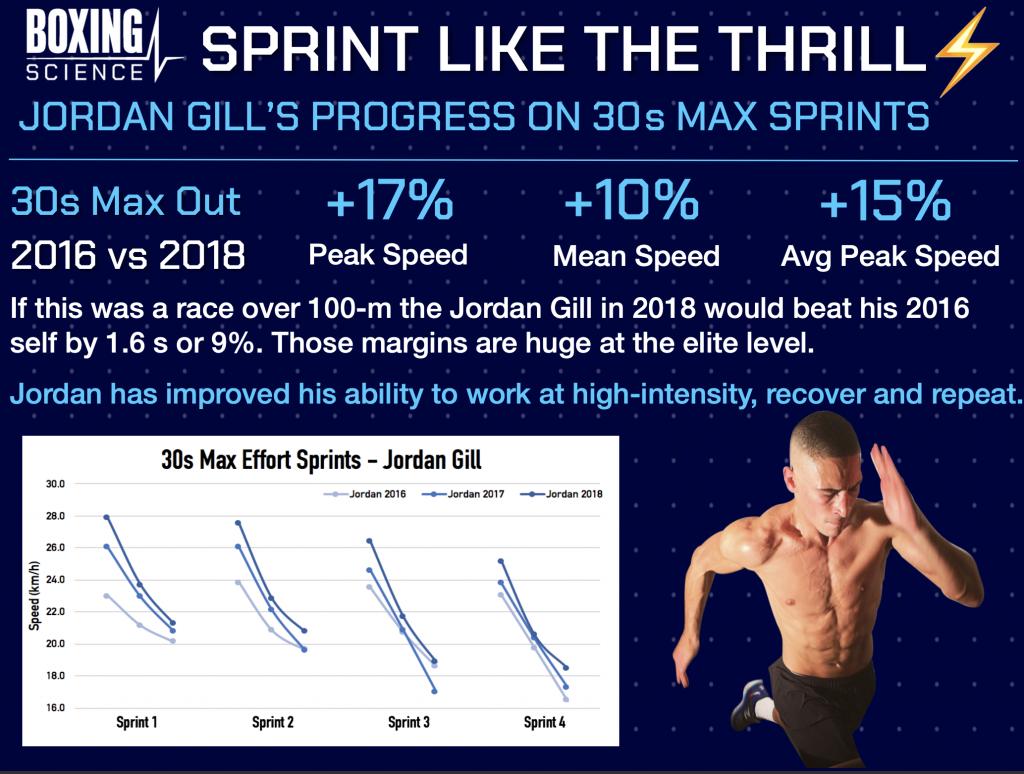
PROGRAMMING CONSIDERATIONS
Thirty second max efforts are usually programmed at the start of camp, far away from heavy sparring weeks and competition.
At the beginning of camp this training method can offer a significant conditioning kick or boost, enabling the athlete to improve fitness rapidly and maximise future training phases.
Despite all of the positives associated with this training method, prolonged sprint intervals should be programmed with caution.
Heavier athletes, boxers returning from injury and athletes unaccustomed to running at high speeds may benefit more from alternative conditioning strategies or at least should be exposed to such high intensities in a gradual manner.
HIGH INTENSITY INTERVAL TRAINING
The second of our most prominent conditioning strategies is high intensity interval training, commonly referred to as HIIT.
These sessions consist of extended high-intensity efforts and target central adaptations.
Targeting central adaptations involves imposing sufficient stress on the heart, blood vessels and other pivotal structures involved in the delivery of oxygen to the muscle cell, forcing them to adapt.
Experiencing significant alteration in these central systems can take time and therefore maximising the stimulus imparted on the athlete whilst being mindful of recovery is essential, especially during short training camps.
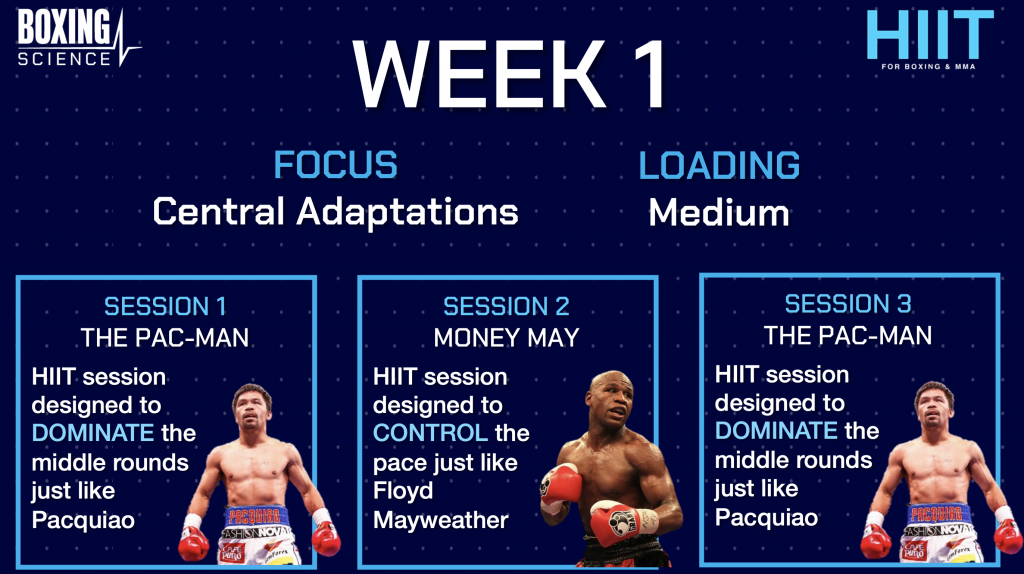
The sessions we prescribe for our athletes are based off of classic protocols used in research concerning both endurance and team sport performance.
Our HIIT sessions will usually be derived from one of the following protocols:
4 mins on : 2 mins off
6 mins on : 3 mins off
8 mins on : 4 mins off
These have been implemented extensively to produce positive changes in V02 max with an array of athletes.
Without doubt, using these sessions is a fantastic starting point, however the intensity of each effort must be appropriate and most importantly, needs to be monitored.

At Boxing Science, the primary means of monitoring training intensity during HIIT sessions, is via a heart rate monitor. We usually use the ‘Wahoo Tickr’ which is an inexpensive alternative to the polar heart rate monitor, and also connects to the Polar App.
During these sessions, we ideally want to spend between 6 and 12 minutes in the Red Zone.
The Red Zone refers to a level of intensity greater than or equal to 90% heart rate max.
At this intensity we are forcing the heart to operate at its maximum pumping capacity and therefore exposing it to significant levels of stress that are required for adaptation.

To maximise time in the Red Zone, training intensity is important. Thus, we will frequently manipulate classic protocols, to allow for higher running speeds, and greater physiological stress.
Examples of this may include splitting 4 minute intervals into bouts of 20 seconds with 10 second recovery.
Employing pyramid sessions is also a great way of breaking up longer interval based sessions and challenging the athlete at a variety of intensities.
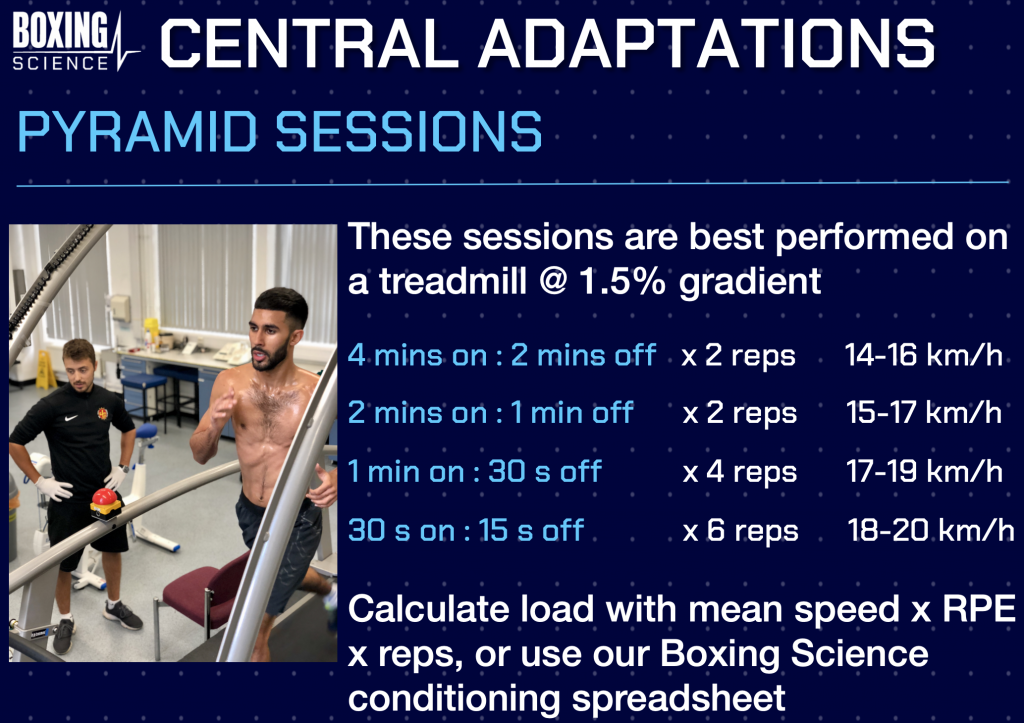
HOW DOES RED ZONE CONDITIONING TRANSFER TO BOXING?
As highlighted previously, the ability of the central structures to deliver blood to the working muscles is a key determinant of V02 max, which is our main measure of aerobic capacity.
Exposing athlete’s to the Red Zone has been repeatedly shown to produce significant improvements in V02 max in a time efficient manner and thus will allow a boxer to achieve notable enhancements in his/her ability to push the pace in the ring.
Additionally, heart rate data confirms that prolonged periods of sparring and competition are performed at an intensity equivalent to the Red Zone.
Whilst at first glance, HIIT sessions may appear to lack boxing specificity, we can be confident knowing that these conditioning strategies are exposing the athlete to similar physiological demands that are encountered in the ring.
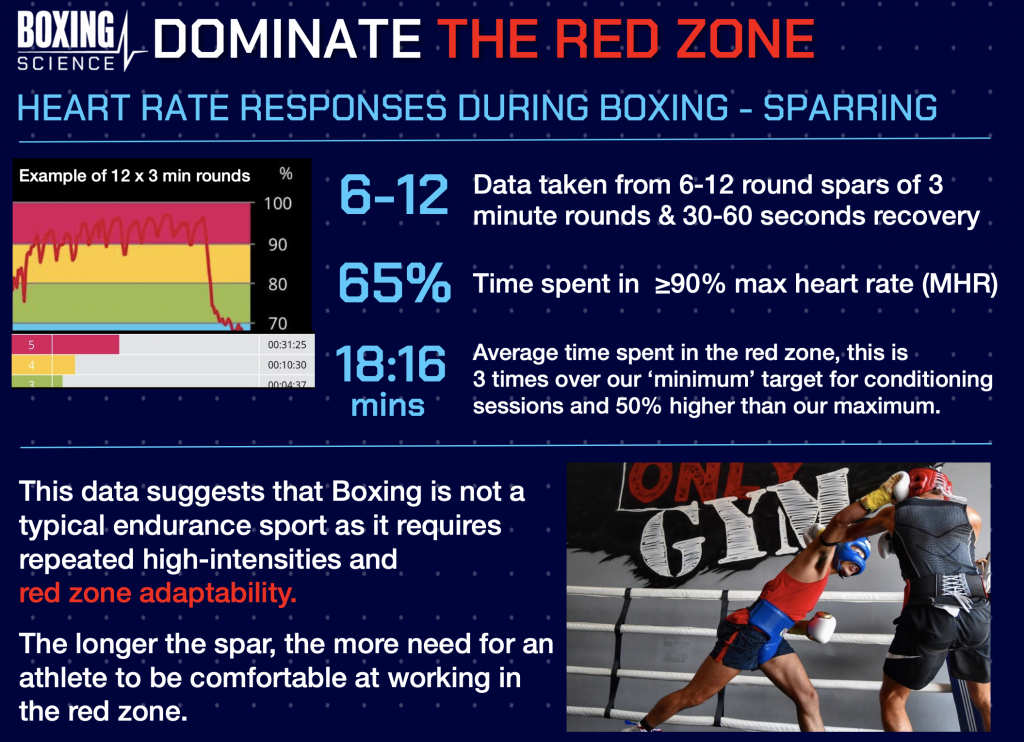
MUSCLE BUFFERING
Considering the points outlined above, we can safely say that boxing isn’t your typical endurance sport and involves intermittent bouts of high and low intensity.
Repeated performance of high-intensity actions leads to the accumulation of lactate and hydrogen ion, creating an acidic environment.
Hydrogen ions are the main issue here, as they stimulate nerve endings which translates to the pain or burning sensation commonly experienced during sustained high force actions.
With evidence suggesting that stoppages/knockouts are proceeded by a series of high force actions it is important to condition the athlete in a manner that allows them to recover quickly from these bouts of activity, before repeating such demanding efforts.
Our standard muscle buffering session consist of 2 minute intervals on the curve, interspersed with 3 minutes recovery, repeated 6-8 times.
The aim is to induce a moderate to high level of acidosis, each interval, usually around 12-14 mmol/l.
Exposing our boxers to repeated bouts of activity at this lactate concentration, stimulate buffering mechanisms that essentially function as mops to clear any metabolites produced due to acidosis.
Successful muscle buffering phases have a profound impact on our athletes’ ability to progress through the gears, force mistakes from the opponent and to capitalise, fully, on these mistakes.

For more information on our muscle buffering and speed endurance strategies CLICK HERE https://boxingscience.co.uk/speed-endurance-training-for-boxing-muscle-buffering-conditioning/
SUMMARY
Boxing is a high-intensity combat sport that heavily relies on aerobic metabolism for energy production whilst also deriving energy from both anaerobic pathways.
V02 max refers to the maximal amount of oxygen that can be uptaken, transported through the blood and utilised for energy during exercise.
At Boxing Science, we target central and peripheral adaptations which improve both the delivery of oxygen to the working muscles and the ability to extract and utilise oxygen for energy.
The main conditioning strategies we employ are grounded in scientific research and have proven to be effective with an array of athletes and include; High Intensity Interval Training (HIIT), Sprint Interval Training (SIT), Muscle Buffering.
For a comprehensive and detailed program that integrates each of these training strategies to take your conditioning to the NEXT LEVEL, check our popular 8 week conditioning program for boxing & MMA.

